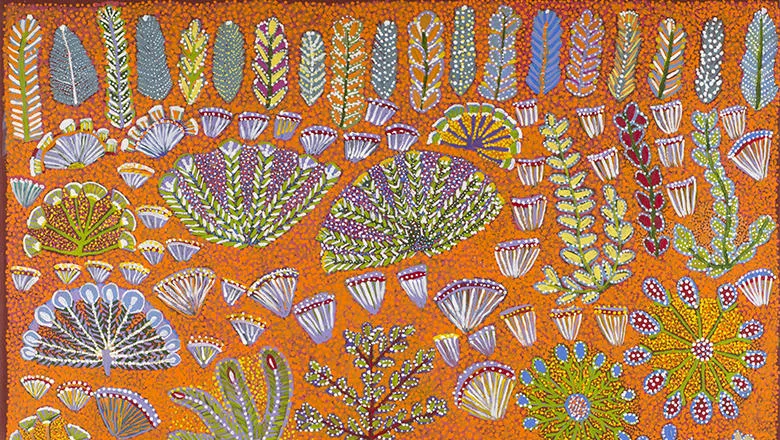The Art of Healing: Healing Images, Healing Stories
A guest lecture with Professor Helen Milroy, University of Western Australia, on the importance of understanding health and...
07 June 2019
Art of Healing exhibition curator, Dr Jacky Healy spoke about the Aboriginal medicines that soldiers were given to help them avoid seasickness.

At the recent launch of the Art of Healing: Australian Indigenous Bush Medicine exhibition at Bush House, King’s College London, the curator of the exhibition, Dr Jacky Healy spoke about the Aboriginal medicine that soldiers were given to help them avoid seasickness.
The Invasion of Normandy, considered by many the most pivotal battle of the 20th Century, would see the final defeat of Hitler. However, the battle itself was delayed until operations could develop a solution for counteracting seasickness. In preliminary excursions, it was found that the very rough waters of the English Channel meant a risk of many of the soldiers crossing becoming violently seasick, rendering them incapable of fighting on arrival at the beaches of Normandy.
In the previous century, Victorian Government Botanist, Baron Sir Ferdinand Jacob Heinrich von Mueller had found that Aboriginal communities used the corkwood tree as medicine for seasickness, which WWII researchers believed could provide the solution for soldiers. In collaboration with Canadian researchers, an operation was developed to collect and air-mail great quantities of this Aboriginal medicine to Europe to be used as the source of the compound for the seasickness tablets.
The medicine was developed in secrecy so that it would be a sole resource for the Allies. D-Day was then scheduled and every soldier that flew or sailed on that day was issued with these pills of Aboriginal medicine, so that they would be capable of fighting in this defining moment of the century. Correspondence from soldiers spoke of this 'mystery pill' and some became so relaxed that they drifted to sleep on the rough journey across the English Channel to only awake upon arrival.
The 'mystery pill' comes from the soft corkwood tree, Duboisia myoporoides, which is found in South Eastern NSW across to Northern Queensland, Australia. This medicine is known to a range of Aboriginal communities and was used for catching fish, in ceremony to connect with the spiritual realm, in a sleeping potion and for a variety of other uses.
It was later discovered that this medicine also provides a valuable source for eye surgery through the production of alkaloid drugs, scopolamine and hyoscyamine, and after WWII, a multi-million dollar industry in Queensland was established – becoming the world’s main supply of eye surgery medicine. This industry still continues today.
On this anniversary, we at the Menzies Australia Institute and across King's College London, pay tribute to all those allied soldiers who took part in the Normandy landings, including those Australian troops so far from home. And we remember that they carried with them not just hopes of a nation but also an example of Indigenous Knowledge in the form of a remedy for seasickness.
The Art of Healing: Australian Indigenous Bush Medicine exhibition looks at traditional Indigenous healing practice, exploring past, present and future approaches to traditional medicine. It presents examples of healing practice through contemporary art from the many distinct and varied indigenous communities throughout Australia and follows the premise of Tjukurrpa (dreaming).
The Art of Healing exhibition runs until 28 June and is open 12.00 to 19.00, Monday to Friday (last entry 18.30). It is free and open to all.
A guest lecture with Professor Helen Milroy, University of Western Australia, on the importance of understanding health and...